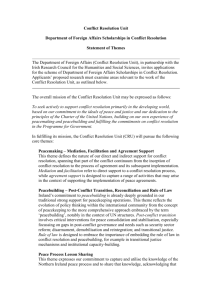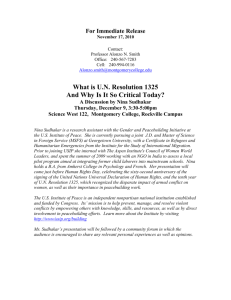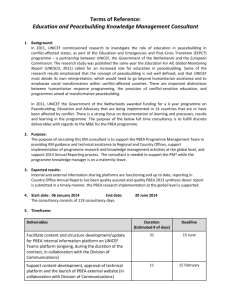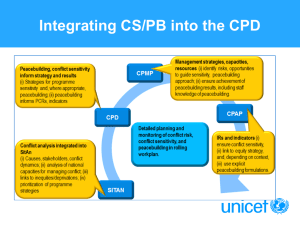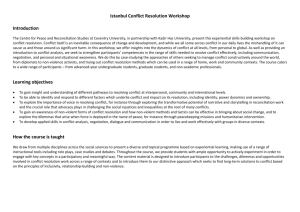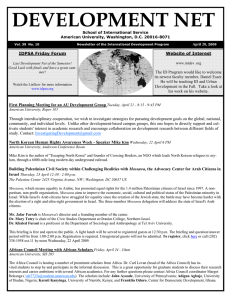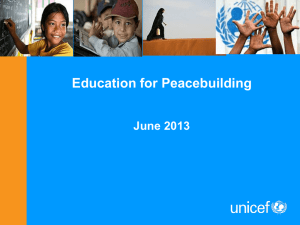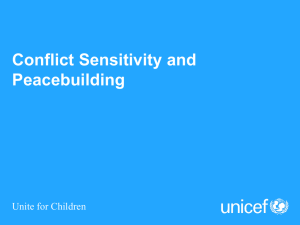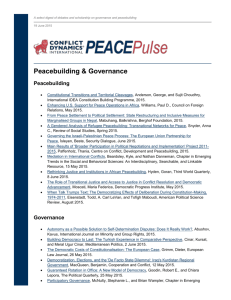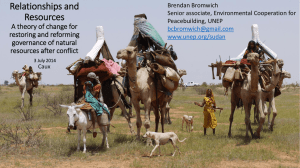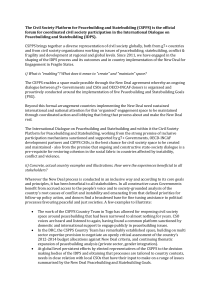Peacebuilding and Education
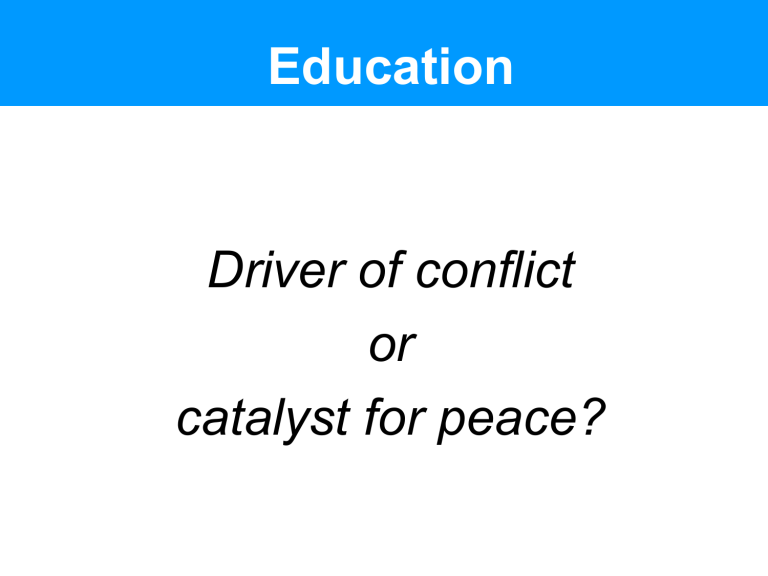
Education
Driver of conflict or catalyst for peace?
The Role of Education in
Peacebuilding
1. Peacebuilding theory has not had a strong influence on education programming.
2. Education for peacebuilding goes beyond ‘do no harm’.
3. Most education programming is not planned from a peacebuilding perspective.
4. The sequencing of education programming is important.
The Role of Education in
Peacebuilding
5. The transition from humanitarian to development funding is an important concern.
6. Peacebuilding requires more attention to education sector reform.
7. Education needs to engage with the UN peacebuilding architecture.
8. UNICEF needs to review the implications of a more explicit commitment to peacebuilding.
Big Picture:
Linkages of education to other spheres
Security
Governance
EDUCATION
Social
Economic Environmental
RELEVANCE OF EDUCATION TO POST-
CONFLICT TRANSFORMATIONS
SOCIAL
Focus Area
Social capital
Social cohesion
Types of Program
Child friendly spaces
Psychosocial support
Resolving inter-group conflict Peace Education
Education about social/cultural rights
Shifting social identities
Social networks
Dealing with the past, truth and reconciliation
Education about coexistence and tolerance
RELEVANCE OF EDUCATION TO POST-
CONFLICT TRANSFORMATIONS
ECONOMIC
Focus Area
Transforming the conflict economy; redirecting resources to development
Types of Program
Programs to support development of relevant skills for economic regeneration
Addressing unemployment Technical and vocational education and training programmes
Developing new skills for economic regeneration
Addressing economic inequalities
RELEVANCE OF EDUCATION TO POST-
CONFLICT TRANSFORMATIONS
POLITICAL/GOVERNANCE
Focus area Types of Programs
Constitutional Reform
Political Institutions
Representation
Elections
Education programs about political rights
Education programs on child rights
Civic and citizenship education
Participation programs
RELEVANCE OF EDUCATION TO POST-
CONFLICT TRANSFORMATIONS
SECURITY
Focus Area
Reintegration
Disarmament
Demobilization
Reintegration
Community safety
Fundamental Freedoms – speech, movement
Types of Programme
Back to school, restoring normality
Education for refugees,
IDPs
Accelerated Learning for former combatants and children who have missed out on learning
Schools as safe places, mine risk education, schools as zones of peace
Human rights education
“Categories” within Education
• Access
• Learning
• Governance/Institutional Capacity
Draft diagnostic tools for assessing conflict sensitivity of Education Programs (USAID, INEE
WGEF, UNICEF)
Learning: Conflict Sensitive
Curriculum and teacher training programs and materials:
• Are free of bias, slander, prejudice, misrepresentation of minority or other groups involved in the conflict, recognize the history, accomplishments, customs, values, and traditions of all social groups
• Promote co-existence, dual narratives of history, gender equity, problem-solving and dispute resolution skills
• Provide teachers with skills in creation of classroom rules and positive discipline
Learning: Creating an Enabling
Environment
• Specific skills promote student well-being
(establishing classroom routines, questioning techniques to ensure ALL students participate and develop a sense of belonging)
• Group work promoting better peer relations
• Language of instruction
• Early Childhood Education
• ALP and Non Formal Education (adolescents)
• Leadership training with a gender approach
• Youth learning linked to entrepreneurship and skills training
Learning: Possible Issues
• Teachers use fair and transparent evaluation criteria of students
• Learner achievement is recognized and course completion documents are provided accordingly
(critical in contexts of return and reintegration of
IDPS and refugees)
• Is the curriculum relevant in a particular context/school environment? (psychosocial support)
Governance: Education Sector
• Teacher management: recruitment, deployment: discrimination, transparency, identity, profile, qualifications
• Financial management, expenditure tracking systems (e.g. for payment of teachers/instructors)
• Indicators and data collection systems established to effectively measure objectives of equitable access and quality education systems
• Accountability and transparency of data for EMIS and HRMIS
Governance: Education Sector
• Support to policy dialogue and formulation for youth
• Accreditation systems (NF/NGO delivered training)
• Restructuring of management: fair representation of marginalized and traditionally underrepresented groups
• Government has financial plans (provision for likely decline in international support in a protracted crisis)
• Extend use of INEE MS by inter-agency coordination group
Stakeholders and Related Issues
Areas to consider: gender, ethnicity, clan, tribe, disabilities, religion, geographic location, urban/rural, age group disaggregation) EQUITY
• Children and youth
• Teachers - AGENTS OF CHANGE- (deployment, payment, accommodation and transportation)
• School community stakeholders (parents, grandparents, PTA and SMC members)
• Education personnel (school monitors, MoE staff at all levels)
• Education planners & policy makers
• Financial allocations to the education sector
(centralized/decentralized, school grants) – sector reform
• Include peacebuilding community in consultations
• Emergency preparedness and DRR – vulnerability versus resilience (complex emergencies)
The Global View
Ongoing work in education and peacebuilding:
- New indicators and approaches to monitoring
(measuring perceptions and attitudes) (PBSO,
UNDP/BCPR, UNICEF, USAID, INEE)
- SPAG
- Nepal: Schools as Zones of Peace (share what works)
- Education in Emergencies and Post Crisis
Transition (evidence, lessons learned, documentation)
- Global Monitoring Report
- Global Coalition to Protect Education from Attack

